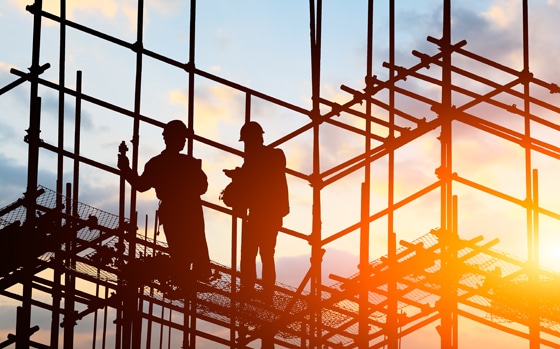-
InsightsInsight - Property Managers and Landlords - POSTED: January 5 2024
High rise buildings and Cladding Remediation Contracts
Developer Remediation Contracts with the Department of Levelling Up, Housing and Communities (DLUHC): notes for landlords and management companies
- Share this article
- Print this article
-

-
As of 7 December 2023, 54 substantial housebuilders (called “developers” in this article) had entered into developer remediation contracts with the Secretary of State for Levelling Up, Housing and Communities. These contracts relate to life-critical fire safety remediation work required to buildings constructed or refurbished by the relevant developer, or a group company of it, in the 30 years prior to 5 April 2022. Those buildings must include dwellings let on leases for more than 21 years and the building must be at least 11 metres high up to the floor of the top floor. There are technical stipulations as to how to measure the height, which need to be checked in each case.
Developer Remediation Contracts are lengthy and complex.
Cladding contracts between developers and freeholders or management companies
Developers are negotiating cladding remediation contracts (cladding contracts) with Responsible Entities (the owners and/or management companies or other persons responsible to leaseholders for the repair of the relevant block) so as to satisfy the developer’s obligations to the government under their developer remediation contract.
Unsurprisingly, cladding contracts can be as complex as the developer remediation contracts. But should Responsible Entities accept them unamended? Some knowledge of recent changes to the law helps answer that.
Responsible Actors Scheme
The government has created a Responsible Actors Scheme. Companies whose main business has been residential development and who have built or refurbished at least one residential building over 11 metres in height that needs cladding remediation will be asked to join that Scheme if their average annual operating profit over a three-year period (companies’ financial years ending 2017, 2018, and 2019) was £10 million or higher. The government has the power to extend the scheme to smaller developers.
One element of the Responsible Actors Scheme is the requirement to enter into a developer remediation contract with the Secretary of State. Those that don’t join the Scheme or, once they do, fail to comply with it (e.g. they fail, through their own fault, to enter into a developer remediation contract) are likely to have planning and building control prohibitions imposed on them, effectively preventing them from carrying out substantial residential development projects.
Building Safety
The Building Safety Act 2022 has brought in sweeping changes to ensure the construction and maintenance of safer buildings in future, with particularly strong control over high-rise blocks with dwellings in them but also to ensure remediation of existing issues.
Cladding
The government has extensive and useful guidance online for leaseholders and others, relating to cladding remediation. In that document, the government makes clear that, in relation to “relevant buildings”, the Building Safety Act: “…fully protects qualifying leaseholders from remediation costs, you are not charged with any costs associated with the remediation of your building. Instead, the landlord is fully responsible for paying or securing funding to remove the cladding from your building.” Read the leaseholder protections on building safety costs frequently asked questions, for more guidance on this.
The government has also set up funds, such as the Building Safety Fund, to assist where, for example, a developer cannot be made to pay for one reason or another.
Entering into a cladding contract with a developer
Leaseholders with cladding and safety issues will want them put right as soon as possible. But they also want the work to be done well, at no cost to them, and with full rights against all those involved in the design or carrying out of the remediation work should their work or designs be defective. The Responsible Entity/Entities (see third paragraph above) will want to have contractual rights to sue those responsible for defective rectification work, either by directly employing them or by obtaining collateral warranties or third-party rights against professionals or contractors employed by, for example, the developer or the main contractor. The quality of those rights depends on their wording and the wording of the underlying contracts, so those contracts also need careful consideration.
Developers also, generally speaking, want to get the work done as soon as possible. Apart from having to comply with their developer remediation contract, they should want to be seen to be acting helpfully, quickly, and responsibly. It should be in their interests too, that contractors and professionals are tied in to good quality contracts and warranties.The professionals advising the Responsible Entity will need a good understanding of the developer remediation contract, so that it knows what the developer has covenanted with the DLUHC to do and to pay for and what it is not obliged to pay for under that contract. For example, the standard developer remediation contract says that the developer is not obliged to pay for interim safety measures (such as waking watch costs) or increases in insurance premiums. Before simply accepting that position, Responsible Entities should check with their lawyers if they or the leaseholders have other rights to recover such costs from the developer or someone else or if a compromise can be agreed.
The developer might want to pass on to the Responsible Entity some of the developer’s obligations in its developer remediation contract. The Responsible Entity should be wary of taking on any expenditure that it cannot recover from the developer or any obligations that it may struggle to comply with.
Some potential issues with cladding contracts
What happens if, for example, during the rectification works, additional problems are found which are not critical to fire safety? It may be sensible for those to be put right at the same time, but is the developer obliged to do so or to pay for them (if it is only funding the remediation rather than procuring the remediation works itself)?
This issue is raised in clause 7.5 of the standard developer remediation contract: if those additional issues have to be put right to enable the fire safety issues to be rectified, then the developer should pay. The cladding contract should at least provide for that. Otherwise, the Responsible Entity will have to pay for them, if it wants them put right. The Responsible Entity might have to find additional funds for that work, very quickly but might also need to go through a time-consuming statutory consultation exercise with the leaseholders first, leading to delays to the works. This scenario needs professional advice and careful thought and negotiation of the cladding contract with the developer. Also, it may be that the Responsible Entity has other rights against the developer or the original contractor or professional team in relation to those other defects and care should be taken not to release or lose any such rights.
Clause 5.11 of the Self-Remediation Terms of the developer remediation contract form requires the developer to retain for at least two years after the date of a Fire Safety Assessment or Fire Risk Appraisal of External Walls, all relevant documentation so that the DLUHC can audit it. It may be that the developer’s contract with the Responsible Entity requires the latter to get those assessments and appraisals done (which leaseholders will want to be at the developer’s cost). The developer will want to be sure that the Responsible Entity retains or copies to the developer all relevant documentation. The Responsible Entity should ensure that its managing agents are contractually obliged to collate and keep those documents and will want the developer to covenant to pay the necessary costs.
Clause 6.3(D) of the developer remediation contract form says that the developer should try to get into the cladding contract an obligation on the Responsible Entity to share relevant information with the leaseholders. Again, the management company or freeholder may depend on its managing agents to do this in practice and will want to know that they are obliged to do so and in a timely way and, ideally, at the developer’s cost.
The cladding contract offered by the developer might also contain a provision that it is in full and final settlement of all claims that the Responsible Entity has against the developer and any group company of the developer, in relation to the fire safety and perhaps other issues. Professional advice and great care need to be taken before a clause like this is agreed by a Responsible Entity.
Summary
It is great news that so much is now being done to sort out fire safety issues in high-rise blocks containing dwellings. It needs to be done urgently so leaseholders can get on with their lives and so that they have flats they can sell. However, the contracts still merit specialist professional input and advice so that they do not turn out to be, at least to an extent, another chance to repent at leisure. The Responsible Entity should seek legal and other appropriate professional advice before entering into a cladding remediation contract with a developer.
This content is correct at time of publication
Can we help?
Take a look at our Property Managers and Landlords page for useful information, resources, guidance, details of our team and how we may be able to help you
-
Key contact:
Get in touch
Please fill out the below form or alternatively you can call us on 01622 690691
